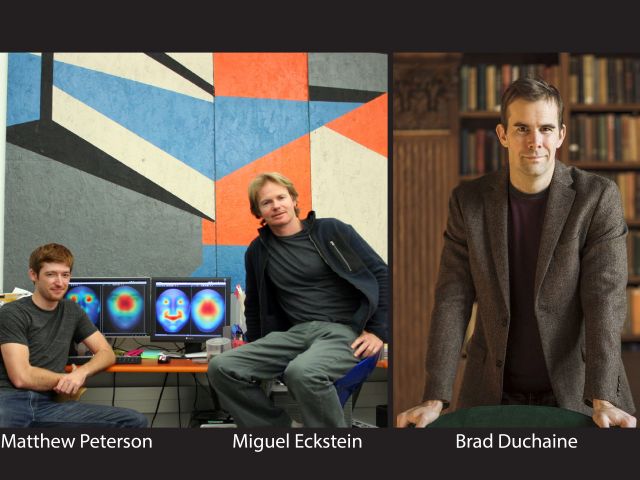Matt awarded NSF grant to study how the way we look at and encode faces changes in childhood and maturity
Studies will be split between UCSB, led by Matt Peterson (Co-PI) and Miguel Eckstein (Faculty), and Dartmouth, led by Brad Duchaine (PI).

One of the VIU's major findings has been the tight link between how we look at faces and how the brain encodes them. Each person has a distinct location where they first look every time they see a face (termed their preferred fixation location, PFL), with some always looking toward the eyes, some toward the mouth, and most in between along the bridge of the nose. Further, each person's ability to recognize faces varies greatly depending on where they are looking, with some able to recognize faces best when looking high on the face and others low (termed their optimal fixation location, OFL). Critically, people who look up toward the eyes recognize faces best when looking near the eyes (i.e., those with high PFLs tend to have high OFLs), while people with low OFLs tend to have low PFLs. This suggests the brain has optimized its face recognition ability through synergistic spatial tuning of eye movements and neural representations. However, the developmental origins and stability across the lifespan of this coordinated system remain unknown: Does the brain learn to look where it does best, or does it learn to do best where it looks? And how malleable is this system during development (childhood) and aging (adulthood)?
To address these open questions and their fundamental implications for the role of visual experience in how the brain learns to see, VIU project scientist Matthew Peterson teamed up with Dartmouth professor Brad Duchaine to write a National Science Foundation (NSF) multi-institute collaborative grant (along with invaluable guidance from VIU head Miguel Eckstein in a Faculty role). The project will measure how eye movements (PFLs) and performance as a function of gaze location (OFLs) for face recognition change (together) through life, and how disruptions to these trajectories may explain impairments to the mature face recognition system, in three distinct populations:
- Neurotypical children, ages 5 to 17, to assess when PFLs and OFLs are established and the relationship between PFL and OFL movement.
- Neurotypical adults, ages 18 to 55, to assess the plasticity of eye movements and neural encoding in mature visual systems well beyond early developmental windows.
- Adults with developmental prosopagnosia (DP) to assess whether disruptions to gaze-encoding synergy can explain the profound face recognition impairment that defines the condition.
The project, which was just accepted and awarded funding for four years, will utilize longitudinal and cross-sectional methods to assess changes with age. The studies follow from Matt's work with Miguel (on optimal eye movements to faces and individual differences in gaze and encoding for face recognition), Nancy Kanwisher (on looking at faces in the real world), and Brad (on face gaze and encoding in DP). Matt, Miguel, and Brad are excited to both fill in the critical gaps in our knowledge of the development of the eye movement and face recognition systems, and to create new experimental paradigms and methodologies for eye tracking in challenging (kids) and clinical (DP) populations.